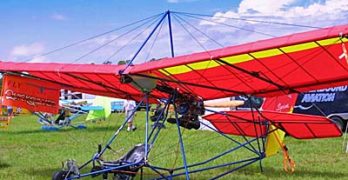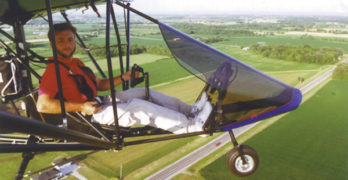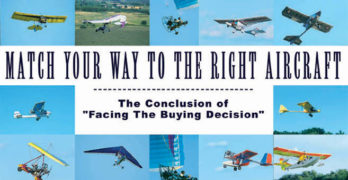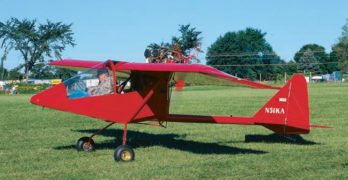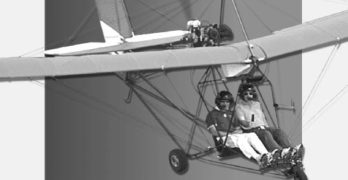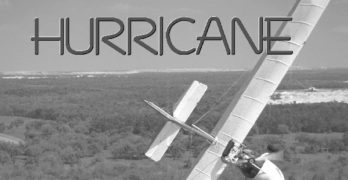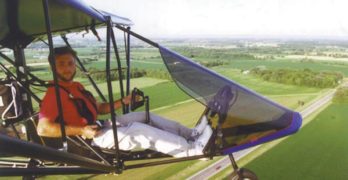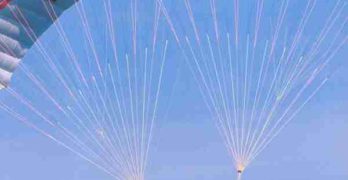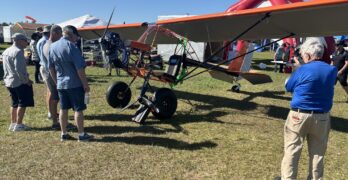You could say 15,000 aircraft buyers can’t be wrong and you’d be right. Quicksilver, in several various corporate iterations, has indeed sold 15,000 aircraft kits for its whole line including what they call the MX series and the GT series. Going back to the early 1980s — or even earlier when the company was a hang glider producer under the namer Eipper Formance — the company has made so many models I could nearly fill a post with the names, so I won’t try to list them all. Suffice it to say this is one of the most prolific airplane companies since the Wright brothers first flew.
Today, the line up includes the aircraft in the nearby photos called Sprint. It’s a single seater, now positioned as the MX-103. As the company notes on their slickly upgraded website, “[We are] launching the MX 103 a legal ultralight with 50 horsepower engine for $18,900 fully assembled.” They note that MX 103 is based on the MX Sprint that has a long track record of safety and ruggedness in an open air flying machine.
Search Results for : Part 103
Not finding exactly what you expected? Try our advanced search option.
Select a manufacturer to go straight to all our content about that manufacturer.
Select an aircraft model to go straight to all our content about that model.
Aero-lite 103
[UPDATE spring 2014] — The Aerolite 103 is now manufacturered in Deland, Florida by U-Fly-It, the contact info for which is located at the end of this article. In addition, a new company is representing the product in Europe under the name Vierwerk. The design appears to be enjoying great interest and support at this time.
[UPDATE summer 2011] — Aero-Works, the company referred to in this article written in 1997, left the business several years ago. During its absence a different producer, Wings of Freedom, offered their Phoenix-103, a derivation of the Aero-Lite 103 but with numerous small changes.
This article refers to the aircraft built by AeroWorks and will not be identical to the Aero-Lite 103. The companies are different and Terry Raber has no association with Wings of Freedom.
Now, in the summer of 2011, I am happy to report the original designer is again the producer of the Aerolite 103, and it retains an excellent price, less than $15,000.
How-to-Buy a Lightplane — Part 3 of 3
In the previous two installments, we’ve discussed you, the pilot, and the many types of aircraft choices you have. As we wrap up this series, we’ll put it all together and try to help you narrow your choices to a few models.
Notice the word “try.” It is important that you understand that it is not possible to direct you to the one-and-only best choice of aircraft. Novice buyers often seek assistance but even experienced pilots can become swayed and end up purchasing the wrong aircraft for their needs and desires. Because aircraft purchases are commonly emotional decisions, it is helpful to gain a “second opinion” to help make a more rational choice.
Many years ago, at the beginning of my career writing articles in light aviation, I made a similar attempt to help hang glider pilots choose the right glider. I compared nine contemporary models to an idealized “perfect” glider and through a series of questions much like those below, tried to steer pilots to the one right glider for them.
How-to-Buy a Lightplane — Part 2 of 3
FACING THE BUYING DECISION, PART II
Last time we discussed the pilot (you!); this time we discuss the many types of aircraft choices you have. In the last installment, we’ll put these together and help you narrow your choices to a few models.
What Kind of Pilot Are You?
Let’s just say you actually know yourself. While this sounds like a comment that deserves a “Duh!” response, don’t be too quick to judge. If every pilot or buyer of aircraft knew what they needed or wanted, my job would be easier. But it isn’t so. Most pilots know something about what they want, but many don’t have enough information to make the best decision.
Some readers are “experts.” A good many ultralight or light plane enthusiasts have been around long enough and owned enough variety of ultralights to know what they like.
These veteran sport aviators represent a lot of combined experience.
How-to-Buy a Lightplane — Part 1 of 3
WANT TO BUY A LIGHTPLANE?
Task Can Be Daunting, Yet Rewarding
I’m one lucky pilot. I love airplanes and get to fly more of them than the average sky jockey. Writing pilot reports for several magazines has given me the opportunity to fly about 250 different aircraft in the last 23 years.
This makes me a “Master of None” type of pilot (except in my own planes) but does give me a feel for the huge variety of light airplanes you can buy.
The choices are fantastic. Counting the whole world of sport aircraft, you can have just about anything you want| and that’s the problem. What to buy?
TRYING TO HELP
At every airshow I attend, and through phone calls between airshow, pilots often make a request: “You’ve flown all these lightplanes, which one should I buy?”
Frankly, the question makes me uncomfortable.
While I appreciate the feeling of confidence some pilots place in my experience, telling someone what to buy is a sure way to be considered wrong eventually.
Tenn. Engineering & Mfg – Max-103
TEAM, builder of the MiniMax, High Max, and other -Maxes, introduced their new Max-103 at Oshkosh 1993. With flowing lines, a snappy paint job and an adorable “convertible” canopy, the Max-103 was a hit with airshow goers.
TEAM president, Scott Severin, was the motivation behind changes to old serial #2 MiniMax, completely transforming it to the beautiful plane above. In order to keep the price low and building easy, the MiniMax has always shown rather boxy lines. The ‘103 was visually striking with fiberglass cowlings, a shapely turtle deck, and sweeping red and blue accent stripes over an clean white base.
Fortunately, TEAM didn’t mess with success, leaving the fine handling and solid feel intact. The MiniMax line is known for light controls with quick-not-jumpy aileron response. Taildragger takeoffs and landings are as easy as most tri-gear designs. A wide-open MiniMax is a joy to fly; the view is tremendous.
Not only is the Max-103 a hot little plane, it carries an absurdly low price tag.
Hurricane Ultra 103
In barely a dozen years, the original Phantom has gone through at least four changes of ownership I can clearly recall. One of the imitators, the Avenger, ceased and was restarted only to stop again (and who knows, maybe it will live on yet?). Another imitator, the Spitfire, has endured at least three owners I can think of, and yet it, too, continues to be an available aircraft to this day. Finally, the Hurricane left the hands of founder Donnie Eccker and was passed to present-day owner Mike Kern.
Published in Light Sport and Ultralight Flying
Seating
Single seat
Empty weight
250 pounds
Gross weight
500 pounds
Wingspan
28 feet 6 inches
Wing area
147 square feet
Wing loading
3.4 pounds/sq ft
Length
16 feet 9 inches
Height
8 feet 3 inches
Load Limit
+6 Gs, -4 Gs
Fuel Capacity
5 gallons
Kit type
Assembly
Build time
80-100 hours
Set-up time
30-40 minutes
Standard engine
Rotax 447
Power
40 horsepower
Power loading
12.5 pounds/hp
Cruise speed
55 mph
Stall Speed
26 mph
Never exceed speed
80 mph
Rate of climb at gross
850 fpm
Takeoff distance at gross
100 feet
Landing distance at gross
120 feet
Standard Features
Flat-bottomed wing airfoil, full-span ailerons, mechanical drum brakes, steerable nosewheel, 4-point shoulder harness, 6-inch aluminum wheels, windshield, pod.
Aero-Lite 103
Manufacturers in the ultralight industry believe they know what pilots want or what they will buy, anyway. A 2-seater is usually part of the answer. But, in fact, many industry watchers are wrong.
While many observers make the statement, ÒNinety percent of ultralights are 2-seaters,Ó statistics tell another story. Nearly 40% of ultralight and microlight aircraft sold in the U.S. are single-seaters, according to Ultralight Flying! magazineÕs surveys of manufacturers. Despite the polling results, however, those experts have a point. Two-seaters do represent the majority of ultralights and microlights sold.
Yet, just when you think 2-seaters are going to take over the whole market, along comes a new trend. Maybe it was FAAÕs lack of action on Part 103 changes, or maybe manufacturers simply decided to take on the challenge of staying within 103Õs tight weight, speed and fuel quantity restrictions. Whatever the correct answer, it doesnÕt change the fact of a growing population of Part 103 ultralights.
Harmening High Flyers — High Flyer 103
Former flight school operators Mike and Susie Harmening obviously know what powered parachute pilots want. The company is thriving and customers relate positive impressions about their contact with the couple. That they build a quality aircraft should therefore come as little surprise.
In a world of single place powered parachutes exceeding the $10,000 mark, the Harmening’s Buckshot offers a great value at $7,995 for an aircraft that can laugh at Part 103 definitions. Tipping the scales at a mere 230 pounds you can afford some accessories; for example, the company says you can install the Rotax 503 (over the standard 447) if you wish.
For well under $10,000, the Harmening family organization can supply their original High Flyer that can be either a one or two seater, and stay under Part 103’s single seat restriction, a nice compliment to the effort to keep weight low. Some other designs seem to get their strength from the sheer quantity of tubing used.
Top Rudder — Have It Your Way
Top Rudder Aircraft, maker of the new Solo (Part 103) and Ruckus (LSA) aircraft, has one of the hottest booths at this year’s Sun ‘n Fun.
The company sold six of 10 available slots it had for planes in 2024 before the show opened on Friday. Both planes are based on a Troy Woodard design that had been around for a while, but it was only three months ago that Bryce Angel started Top Rudder to make these ultralight and light sport variants.
“It’s designed like a 1300-pound aircraft that’s we’ve modified for two entirely different kinds of flying,” explains Top Rudder’s Chief Engineer George Boney. “It can handle up to 200 hp, but our standard Polini 303 allows for stall speeds under 20 mph and a cruise of 50 for ultralight flying. Or, you can add another fuel tank, a slightly larger engine and tires and have an inexpensive backcountry sport plane that has real STOL capabilities.”
In its sport configuration with the Polini, the plane weighs about 350 pounds and is capable of limited acrobatics.
- « Previous Page
- 1
- …
- 6
- 7
- 8
- 9
- 10
- …
- 53
- Next Page »


